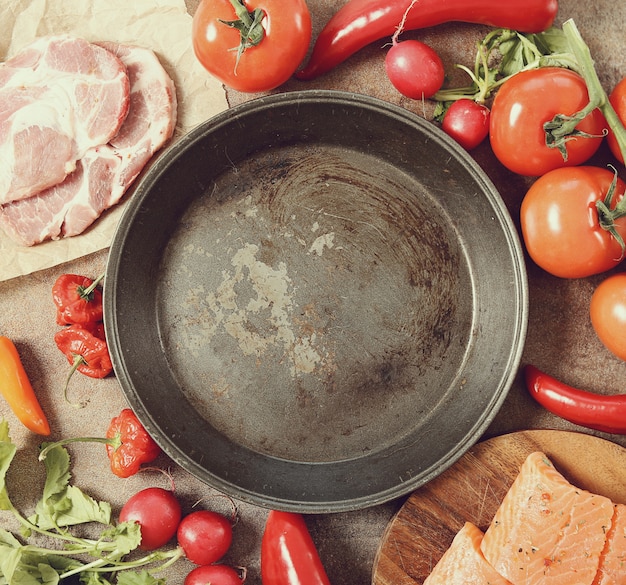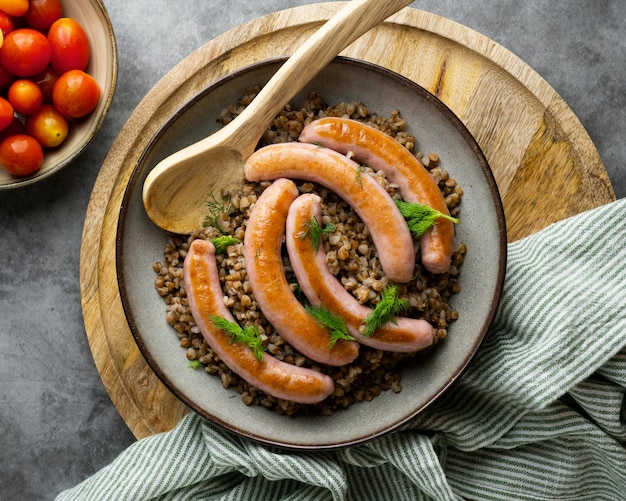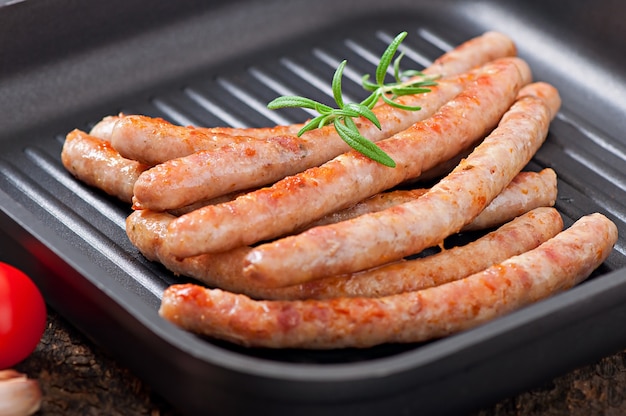Let's talk italian sausage, a culinary staple in my kitchen and probably yours too. This versatile meat is always a winner, whether you're whipping up a quick weeknight dinner, a fancy feast, or a Sunday roast. And cooking it in a pan? Easy peasy!
I've been cooking italian sausage for years, and trust me, I've picked up a few tricks along the way. There are some key things to keep in mind to get that perfect golden-brown crust and juicy interior.
So, grab your frying pan, a pinch of salt, and let's get cooking!
(Part 1) – Choosing the Right Sausage

First things first, we need to choose the right sausage. This is the foundation of your dish, so you want to get it right. Now, Italian sausage comes in a variety of forms, from mild to spicy, sweet to savory. You can find it fresh, pre-cooked, or even in links. I personally prefer the classic, sweet italian sausage – it's super versatile and works well in a wide range of dishes.
types of italian sausage
If you're feeling adventurous, there's a whole world of Italian sausage to explore! Here's a rundown of some common types:
- Mild Italian sausage: A great starting point, especially if you're not a fan of spicy food. It's got a gentle flavor and works well in simple dishes like pasta sauces and sandwiches.
- spicy italian sausage: This is for those who like a bit of heat. Often made with chili peppers, it has a fiery flavor that will add some excitement to your meal.
- Sweet Italian sausage: My personal favorite! Typically made with pork and fennel, it has a slightly sweet and savory flavor that's fantastic for hearty dishes like pasta and pizza.
- Chicken Italian sausage: A great option for a lighter meal. Made with ground chicken, it has a milder flavor than pork sausage and is perfect for dishes where you want to cut back on fat and calories.
- Turkey Italian sausage: Another lean alternative to pork sausage. Made with ground turkey, it has a slightly blander flavor, so it's best used in dishes with bold flavors, like pasta sauces with strong spices and cheeses.
Remember, the type of sausage you choose will influence the final flavor of your dish, so pick one that complements your recipe.
(Part 2) – Prepping the Sausage

Once you've chosen your sausage, it's time to prep it. This step is super easy, but it's important to make sure your sausage is ready to go before you start cooking.
Preparing the Sausage
- Remove the casing (if necessary): If you're using sausage links, you'll need to remove the casing before cooking. This is a simple process – just grab your sausage link and run a sharp knife down the length of the casing. It's like peeling a banana, but with a sausage!
- Break the sausage apart: Once the casing is removed, break the sausage apart into smaller pieces. You can do this with your hands or use a spoon. Don't worry about making them perfect, just make sure they're evenly sized. This will ensure even cooking.
Storing Sausage
If you're not planning on cooking your sausage immediately, it's essential to store it properly to maintain its quality.
- Refrigerate: If you're using fresh sausage, store it in the refrigerator for up to two days.
- Freeze: If you're not using your sausage within a couple of days, you can freeze it. To freeze sausage, place it in a freezer-safe bag or container and freeze for up to three months.
Here's a little secret: If you're using frozen sausage, you can cook it straight from the freezer. Just add a few extra minutes to the cooking time.
(Part 3) – Pan-Frying the Sausage

Now, let's get down to the nitty-gritty of pan-frying your sausage. This is where the magic happens! We're going to get that delicious, crispy exterior and juicy, flavorful interior.
Choosing the Right Pan
The first step is choosing the right pan. I recommend using a cast-iron skillet or a heavy-bottomed pan. These pans distribute heat evenly, which is essential for cooking sausage to perfection. You want to make sure that your sausage is evenly cooked throughout and doesn’t burn on the outside.
If you don't have a cast-iron skillet, a good quality stainless steel pan will also do the trick. Just make sure it's not too thin or flimsy, as it won't retain heat as well.
Heating the Pan
Once you've chosen your pan, it's time to heat it up. You want your pan to be nice and hot before you add the sausage. This will help create that lovely crispy crust we all crave. I usually heat my pan over medium-high heat, which usually takes about 5 to 7 minutes. But make sure to pay attention to your pan and its heat distribution as different pans heat differently. You can also test the heat by flicking a few drops of water on the surface – if it sizzles and evaporates quickly, your pan is ready.
Adding the Sausage
Now, it's time to add your sausage to the pan. Be careful, because the pan will be hot! It's a good idea to use a spatula or tongs to transfer the sausage. Don’t overcrowd the pan; you want to leave some space between the pieces of sausage so they cook evenly. If you have too much sausage in the pan, it will steam instead of brown.
Cooking the Sausage
Let the sausage cook for about 5 to 7 minutes per side, or until it's golden brown and cooked through. Don't move the sausage around too much, let it cook undisturbed for a few minutes. This will help it develop that nice crispy crust.
Using a meat thermometer is the best way to ensure your sausage is cooked through. It should reach an internal temperature of 160°F (71°C). If you don't have a meat thermometer, you can check the sausage by cutting into it. If the juices run clear and there's no pinkness, it's cooked through.
Removing the Sausage
Once the sausage is cooked, remove it from the pan and place it on a plate lined with paper towels to absorb any excess grease. This will help keep your sausage crispy and prevent it from getting soggy.
Using the Rendered Fat
Don't throw away that rendered fat! It's full of flavor and can be used to cook other things. You can use it to sauté vegetables, make a delicious sauce, or even fry up some eggs.
If you're worried about the fat content, you can skim some of it off before using it. But I say embrace the deliciousness!
(Part 4) – Seasoning the Sausage
Now, let’s talk about seasoning. You can season the sausage before cooking or after, but I prefer to do it before cooking so the flavors can really meld. This is a great way to add extra depth and complexity to your dish.
Basic Seasoning
A simple sprinkle of salt and pepper will elevate the flavor of your sausage. You can't go wrong with this classic combination. A pinch of garlic powder or onion powder can also add a nice touch.
Italian Seasoning
Italian seasoning is a fantastic option for sausage. It's a blend of dried herbs, including oregano, basil, rosemary, and thyme, perfect for creating an authentic Italian flavor. I always keep a jar of Italian seasoning in my pantry for a quick and easy way to add flavor to my dishes.
Other Seasoning Options
If you're feeling adventurous, there are many other seasonings you can experiment with:
- Crushed red pepper flakes: Add a touch of heat to your sausage.
- Fennel seeds: These seeds have a sweet licorice flavor that complements the sausage nicely.
- Fresh herbs: If you have some fresh herbs on hand, feel free to use them. Chopped parsley, basil, or oregano can add a burst of flavor.
You can also experiment with different combinations of seasonings to find your perfect blend.
(Part 5) – Cooking the Sausage with Other Ingredients
Now, let's get creative! You can cook your sausage with all sorts of ingredients to make a delicious and satisfying meal.
Sausage and Peppers
A classic combination! Cook the sausage with bell peppers, onions, and garlic. The sweet and savory flavors of the peppers complement the sausage perfectly, and the onions and garlic add a depth of flavor. This combination is perfect for making a filling pasta sauce or a hearty sandwich.
For a sweet and smoky twist, try adding a little smoked paprika to the pan.
Sausage and Mushrooms
Sausage and mushrooms are a match made in heaven. You can cook the sausage with any kind of mushrooms you like, but I love using cremini or portobello mushrooms. The earthy flavor of the mushrooms complements the savory sausage beautifully. This combination is great for making a rich and satisfying pasta dish or a flavorful stir-fry.
Try adding a splash of white wine to the pan for an extra layer of flavor.
Sausage and Potatoes
A hearty and comforting combination. Cook the sausage with potatoes, onions, and garlic. This is a perfect meal for a cold winter's day. You can make a classic sausage and potato stew or a comforting skillet meal.
For a more rustic dish, try adding some rosemary or thyme to the pan.
Sausage and Vegetables
Get creative with your vegetables! You can cook the sausage with any vegetables you like. Try adding zucchini, squash, eggplant, or asparagus.
For a lighter meal, try cooking the sausage with a mix of seasonal vegetables like broccoli, carrots, and Brussels sprouts.
(Part 6) – Serving the Sausage
Right, your sausage is cooked, seasoned, and ready to serve! You can serve it up in many ways. This is where you can really let your creativity shine!
Serving Ideas
- On a bun: A classic way to serve sausage. Just add some toasted buns, mustard, and relish, and you're good to go.
- In a pasta dish: Use the cooked sausage to make a delicious pasta sauce. Add some chopped vegetables, tomatoes, and herbs to make a flavorful and hearty dish.
- With potatoes and vegetables: A classic and comforting meal. Serve the sausage with mashed potatoes, roasted vegetables, and a gravy.
- On a pizza: A delicious and easy way to use up leftover sausage.
- In a salad: Add some cooked sausage to a salad for a hearty and satisfying meal.
- With eggs: Cook the sausage with eggs for a quick and easy breakfast or brunch.
You can also use the cooked sausage to make a variety of other dishes, such as sausage balls, sausage and peppers, and sausage and gravy. The possibilities are endless!
(Part 7) – Tips and Tricks
Here are a few tips and tricks to help you make the best pan-fried Italian sausage:
Tips
- Don't overcrowd the pan: This will make the sausage steam instead of brown.
- Use a meat thermometer: This is the best way to ensure your sausage is cooked through.
- Let the sausage rest: This will help it retain its moisture.
- Don't be afraid to experiment: Try different seasonings and ingredients.
Tricks
- Add a splash of water: If the pan starts to dry out, add a splash of water to create steam and help the sausage cook evenly.
- Use a wooden spoon: This will help prevent the sausage from sticking to the pan.
- Add a bit of sugar: If you're using sweet Italian sausage, add a pinch of sugar to the pan to balance out the savory flavors.
Don't be afraid to get creative with your cooking! The best chefs are always experimenting and trying new things.
(Part 8) – FAQs
Here are some frequently asked questions about cooking Italian sausage in a pan:
What if my sausage is too spicy?
If you find your sausage is too spicy, try adding some sweet ingredients like honey or brown sugar to the pan. You can also try adding some dairy, such as milk or cream, which will help to tone down the spice.
How long can I keep cooked sausage in the fridge?
You can store cooked sausage in the refrigerator for up to three days. However, I recommend using it within two days for the best flavor.
Can I freeze cooked sausage?
Yes, you can freeze cooked sausage. Just let it cool completely, then place it in a freezer-safe bag or container. It will keep in the freezer for up to three months.
When you're ready to use the frozen sausage, thaw it in the refrigerator overnight or microwave it on a low setting.
Can I use Italian sausage in other dishes?
Absolutely! You can use Italian sausage in a variety of dishes, including pasta sauces, soups, stews, pizzas, salads, and sandwiches. You can also use it to make sausage balls, sausage and peppers, and sausage and gravy.
How can I tell if my sausage is cooked through?
The best way to tell if your sausage is cooked through is to use a meat thermometer. The internal temperature should reach 160°F (71°C).
You can also tell if the sausage is cooked through by checking the color. It should be a consistent brown color throughout, without any pinkness.
(Part 9) – Conclusion
Well, there you have it! A simple guide to cooking Italian sausage in a pan. You've got your sausage, you've got your pan, you've got your seasonings, and you've got this!
Remember to have fun, experiment with different flavors and ingredients, and most importantly, enjoy your delicious sausage.
Happy cooking!
Everyone is watching

How to Cook Frozen Lobster Tails Perfectly: A Step-by-Step Guide
RecipesLobster. Just the word conjures up images of lavish meals, special occasions, and a taste of luxury. But let's...

Pigs in a Blanket Cooking Time: How Long to Bake for Perfect Results
RecipesAh, pigs in a blanket. Just the name conjures up images of those delightful little parcels of crispy pastry en...

Pork Fillet Cooking Time: How Long to Cook It Perfectly
RecipesPork fillet, or tenderloin as it's sometimes called, is a real favourite in our house. It's so versatile, and...

The Ultimate Guide to Tender, Juicy Pulled Pork
RecipesRight, let's talk pulled pork. It's one of those dishes that just screams "comfort food," doesn't it? I mean...

The Ultimate Guide to Cooking Sweet Potatoes: From Roasting to Mashing
RecipesSweet potatoes. Just the name conjures up images of warm, comforting dishes, bursts of vibrant color, and a to...
